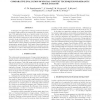Free Online Productivity Tools
i2Speak
i2Symbol
i2OCR
iTex2Img
iWeb2Print
iWeb2Shot
i2Type
iPdf2Split
iPdf2Merge
i2Bopomofo
i2Arabic
i2Style
i2Image
i2PDF
iLatex2Rtf
Sci2ools
WIAMIS
2009
IEEE
2009
IEEE
Comparative evaluation of spatial context techniques for semantic image analysis
In this paper, two approaches to utilizing contextual information in semantic image analysis are presented and comparatively evaluated. Both approaches make use of spatial context in the form of fuzzy directional relations. The first one is based on a Genetic Algorithm (GA), which is employed in order to decide upon the optimal semantic image interpretation by treating semantic image analysis as a global optimization problem. On the other hand, the second method follows a Binary Integer Programming (BIP) technique for estimating the optimal solution. Both spatial context techniques are evaluated with several different combinations of classifiers and lowlevel features, in order to demonstrate the improvements attained using spatial context in a number of different image analysis schemes.
| Added | 21 May 2010 |
| Updated | 21 May 2010 |
| Type | Conference |
| Year | 2009 |
| Where | WIAMIS |
| Authors | Georgios Th. Papadopoulos, Carsten Saathoff, Marcin Grzegorzek, Vasileios Mezaris, Ioannis Kompatsiaris, Steffen Staab, Michael G. Strintzis |
Comments (0)

